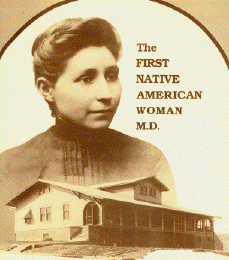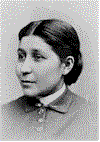History
-

Picotte Elementary School opened its doors for the first time in the fall of 1992. We began our first year in a rental building at 1312 Robertson Drive because our permanent structure was still under construction. On March 25, 1993, we moved to our brand-new building at 14506 Ohio St.
Our school was named after Dr. Susan La Fleshe Picotte. Dr. Picotte was a member of the Omaha Indian Tribe and a significant contributor to the cultural and life experiences of many Nebraska citizens. She was the first Native American woman to become a doctor.
Throughout our years the grade-level structure has changed, but what hasn't changed is that we are proud of our school. Go Pintos!
More Picotte History
-

Susan LaFlesche Picotte (1865-1915) was the first Native American woman physician. She was a member of the Omaha Tribe raised on the Tribe's reservation in Nebraska. She was the youngest daughter of Mary and Joseph LaFlesche. Mary was a daughter of Dr. John Gale and Ni-co-mi of the Iowa tribe. Joseph, also known as Iron Eye, was a son of Joseph LaFlesche, a French trader and his wife, a woman of the Ponca tribe. Iron Eye was the last recognized chief of the Omaha. Between 1870 and 1879 Susan attended school on the reservation. At the age of 14, she enrolled at the Elizabeth Institute for Young Ladies at Elizabeth, New Jersey. Here she studied philosophy, physiology, and literature. After she was graduated in 1882, Susan worked at the Mission School on the Omaha reservation until 1884. Along with two of her sisters, she attended Hampton Normal and Agricultural Institute in Virginia from 1884 to 1886.
Susan then entered Women's Medical College of Pennsylvania at Philadelphia, receiving financial aid from the Women's National Indian Association. She was graduated, first in her class of thirty-six members, in 1889 with a medical degree. After interning for one year at Women's Hospital in Philadelphia, Susan returned to the Omaha reservation to become a physician for the government school. Later she became government physician for the Omaha Tribe. She was the only Indian ever appointed as a medical missionary by the Presbyterian Board of Home Missions.
In 1894 Susan married Henry Picotte. They were the parents of two sons. After her marriage, Dr. Picotte resigned from government school work and settled at Bancroft where she cared for her family and her ailing mother and also provided medical care for Indians and for her white neighbors. In 1905 Henry Picotte died. The next year Dr. Picotte, along with her sons and her mother, moved to the new community of Walthill to live near her sister, Marguerite Diddock. The two sisters were active in the community, sponsoring religious and community activities.
Dr. Picotte was also active in medical organizations. She was one of the founders of the Thurston County Medical Association. As county health officer, she was involved in public health issues. She lobbied at the State Legislature for better public health laws. As a member of the State Medical Association, Dr. Picotte worked to combat alcoholism among the Omaha, and she lectured in favor of temperance. Her father, Joseph LaFlesche, had worked successfully for temperance among the Omaha for many years. In 1906 Dr. Picotte's work brought about in Washington, D.C. a stipulation that every property deed in communities on the Omaha reservation would prohibit the sale of alcohol. Dr. Picotte was an able spokesperson for her people,declaring that she would cooperate with the Indian Agencies in anything that was for the good of the tribe. She battled government bureaucracy and worked for economic, social, and spiritual advancement of native Americans.
She suffered from a painful and degenerative bone disease that caused severe pain in her ear for about 20 years, and that eventually took her life. Despite her own diminished health, she continued a daunting daily schedule and always left a lighted lamp in the window of her home to welcome patients in the night.
In addition to her pioneering medical career, Dr. Picotte was a church and community leader, public health advocate, and Indian rights activist. Her life was devoted to promoting health, healing illness, serving community, and fostering respect between races.
Near the end of her life, she accomplished a goal that had eluded her many years. She raised the funds necessary to construct a hospital on the reservation in the town of Walthill in 1912. After her death on September 18, 1915, it was named in her honor. The hospital served both Native Americans and whites for over 30 years, then served as an elder care center for another 20 years.
In 1989, the building was rescued from deterioration by a local multi-racial committee.and it now displays photos and artifacts from Dr. Picotte's life. Named the Susan LaFlesche Picotte Center, it commemorates Dr. Picotte's medical work and her life, dedicated to the welfare of her people.

